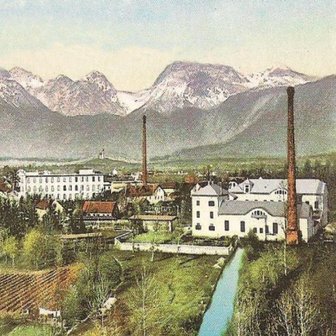ON THE INDUSTRIAL HISTORY OF SLOVENIA
Slovenia was considered a part of the agricultural periphery of the Habsburg Empire for centuries. However, wherever economic potential became apparent between the Alps and the Adriatic, Austria’s rulers, or entrepreneurs flush with capital, were on the spot and established local, productive trade and industrial locations. The “Iron Barons” exploited the ore deposits in the Sava Valley starting from the Middle Ages. The forges specialized in nails, from small tacks for footwear to long spikes for dam construction. However, the Slovenian export in greatest demand was quicksilver from Idrija. By the 18th century, the mines and smelters, in operation since 1509, had become the world’s largest quicksilver producer. At about the same time, Hrastnik on the Sava witnessed the emergence of glass manufacturing, an industry that still flourishes today, in addition to the coal mines.
Also at this time, the Habsburgs developed Trieste into a major trading port. As handling volumes increased, more and more merchants settled there and established an exchange, insurance companies and banks. Therefore, Slovenia’s first surge of industrialisation starting in the mid-19th century was financed largely with capital from Trieste, for instance the TKI chemical works in Hrastnik, which still exist today. The first steam engines were deployed in Ljubljana. Foreign-controlled corporations acquired the iron works at Jesenice and the coal mines in Trbovlje. However, agricultural and forestry products such as food, leather, wood and paper remained dominant. The government in Vienna determined where rail lines were built. The Southern Railway from Vienna to the Adriatic had priority, connecting Celje and Ljubljana in the 1840s and Trieste in 1857. Connections from Carinthia via Jesenice followed in the 1870s, with a second line to Trieste going into operation at the start of the 20th century.
After the dissolution of Austria-Hungary and the proclamation of the “Kingdom of Serbia, Croatia and Slovenia” in 1918, the country found itself in an entirely new situation: cut off from the flourishing Adriatic port of Triest and the Austrian hinterland, but now with access to the hungry markets of the southern Balkans. Comparatively well developed Slovenia now attracted capital, and mining and iron-working expanded, along with food production, textile and paper industries. The number of factories had almost doubled by the beginning of the Second World War, although most of these operations were small and the rural population continued to suffer high unemployment.
It was the government of the Socialist Federal Republic of Yugoslavia that succeeded in industrialising the country after 1945 – at the price of a severe scarcity of consumer goods. Companies were nationalised and heavy industry was given absolute priority. Metal working and machinery production increased at a breathtaking pace, and automotive production was relaunched: TAM in Maribor began making trucks and buses in 1947, and in 1954 IMV in Novo Mesto started producing passenger cars. Both companies mainly manufactured under license from Western European corporations such as Austin, Magirus, Citroën and Renault. The equally newly established electrical industry brought forth such companies as the kitchen equipment manufacturer Gorenje. New power stations like the coal-fired TEŠ plant in Šoštanj and since 1970 the nuclear power station in Krško, half-owned by Croatia, improved the supply of electricity. New production plants were systematically sited all over the country to put an end to rural unemployment.
However, the government in Belgrade was unable to set self-sustaining economic development in motion, despite constant adjustments: greater autonomy for businesses, a limited opening of the market and freer access to the West. Growth was driven by increasing resource consumption, which ultimately resulted in declining incomes, a trade deficit and massive foreign debt. When the federal state fell apart in 1991, relatively prosperous Slovenia was in the best position to adapt to the new, capitalist market, mainly on account of an industrial base highly oriented toward finished goods, its high educational level and a great proportion of services.
Slovenia was part of the 'Socialist Federal Republic of Yugoslavia', which disintegrated since 1991.
Therefore, for completeness, please also read our articles on the industrial history of the other states that were formerly part of Yugoslavia.
Bosnia and Herzegovina
Croatia
Kosovo
Montenegro
North Macedonia
Serbia


